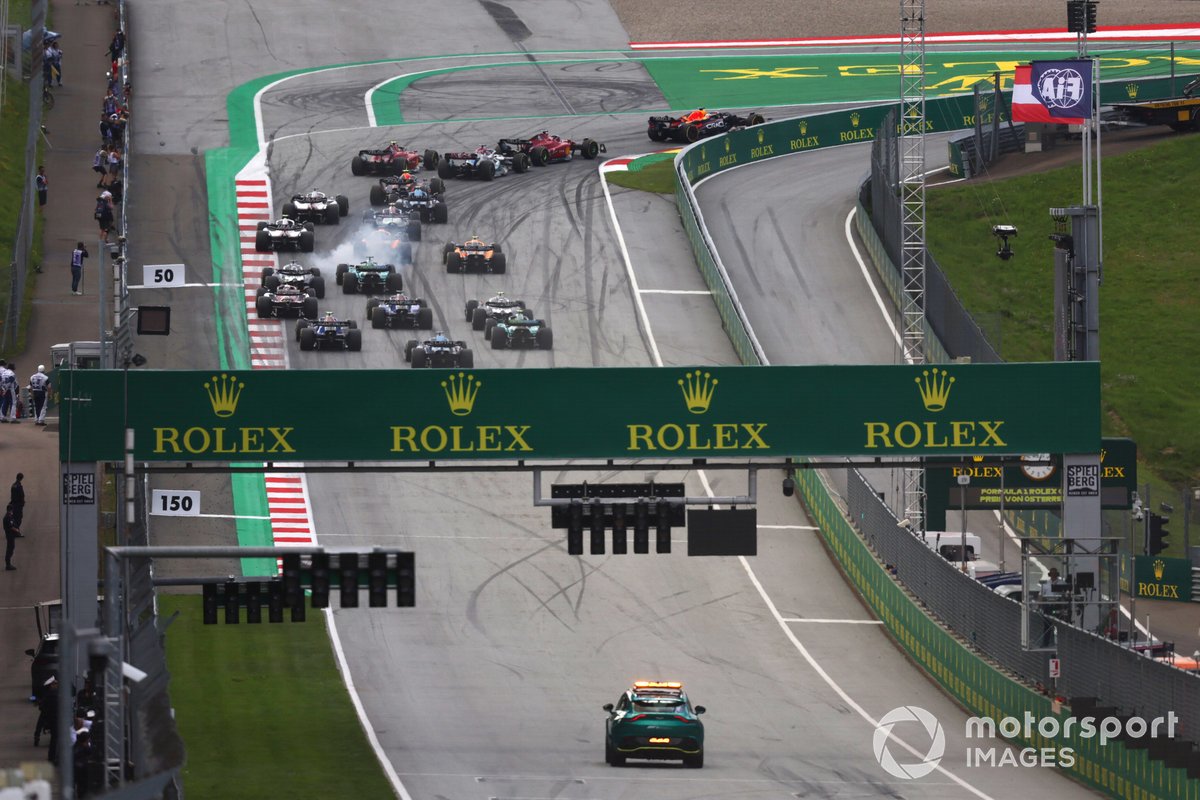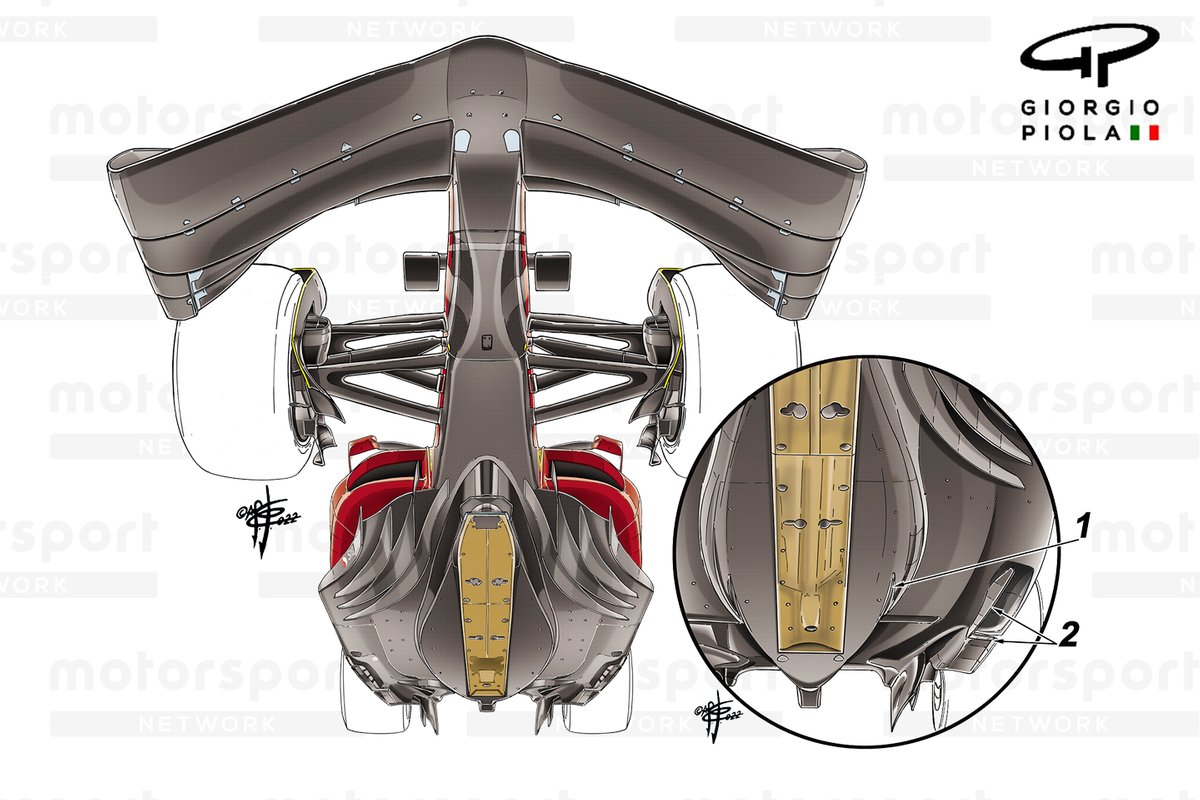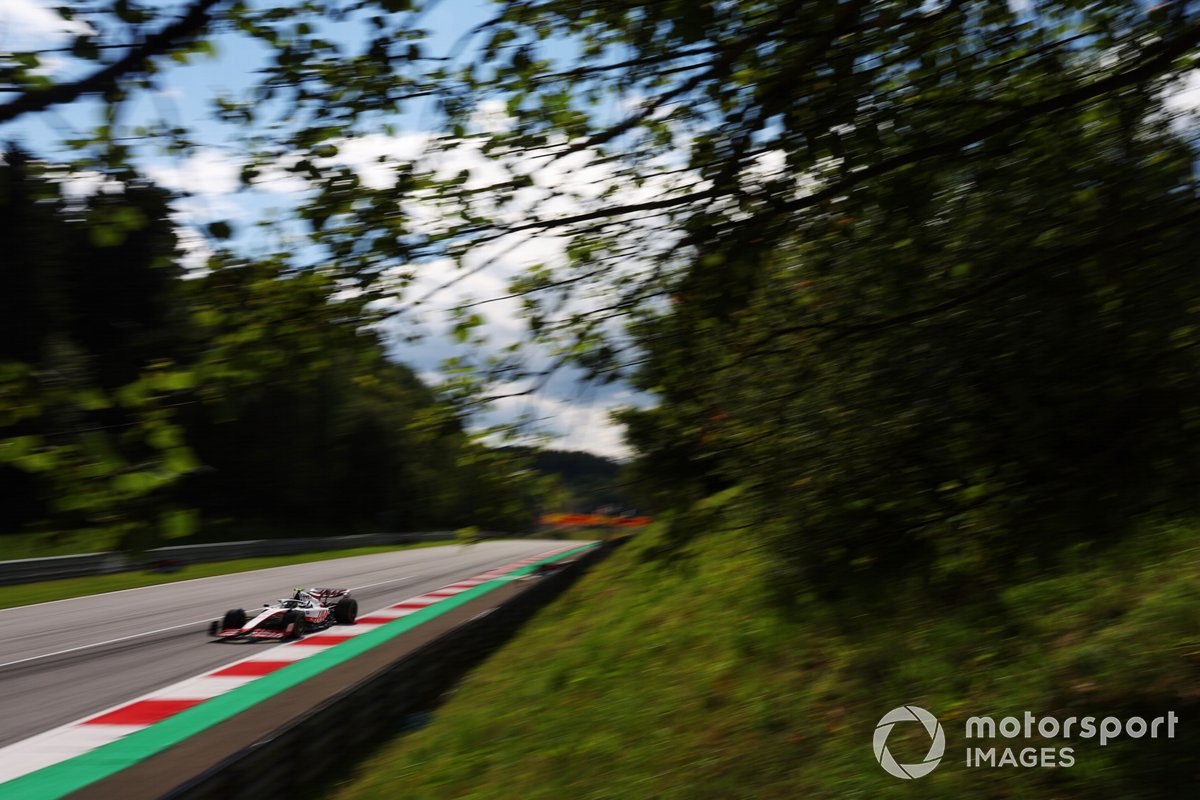
It didn’t look like the 2022 Austrian Grand Prix was going to end in anything other than Max Verstappen and Red Bull domination a few laps into last Saturday’s sprint race. That Ferrari and Charles Leclerc were able to grab a morale-boosting main race win the next day is the main sporting takeaway from the event that marks this season’s halfway stage.
But there were plenty of other talking points – and sadly, not all of them good.
In racing terms, Ferrari is faced once again with a severe reliability drama to address, while, much more importantly, Formula 1 and the Red Bull Ring have serious questions to answer regarding the shocking instances of fan harassment and abuse reported over the weekend.
Here are 10 things we learned from the 2022 Austrian GP weekend.

1. Ferrari can deliver an important psychological victory on Red Bull turf…
In the two 2021 Formula 1 races at the Red Bull Ring, Max Verstappen led all the combined 142 laps to go along with his 2018 and 2019 Austria victories. That Ferrari beat Red Bull to victory on home soil and in such a thumping manner when its reliability issues are discounted, is a serious boon to the Scuderia, its fans and the neutrals wanting the title fight to go the distance.
PLUS: How Leclerc beat Verstappen in Red Bull’s backyard after F1 sprint defeat
“I don't completely agree,” replied team boss Mattia Binotto when it was suggested this was Ferrari’s best showing since Leclerc’s Melbourne domination. “Barcelona was one of those races where we're very strong. Monaco was one of those races where we're very strong. But yeah, since those races ...yeah, it's been the first time where we were actually quite a bit quicker.”
Although Sainz had ended Ferrari’s six-race losing streak at Silverstone the previous week, its team orders and strategy shambles overshadowed a day when it should’ve fully capitalised the faster Red Bull being badly hobbled. But in Austria, Ferrari ended up just 0.029s shy of pole and finally showed it has indeed made progress on the soft-compound tyre management woes that cost it victory in the two races that preceded its luckless-streak starting in Spain. Now, with a psychological blow struck that works both ways – boosting its own morale and showing Red Bull the title fight isn’t as over as it seemed – Ferrari simply must capitalise on its momentum.
“I definitely needed that one,” said Leclerc.

2. … But Ferrari’s on-going issues in several areas should temper expectations
Let’s not get carried away. Although Ferrari’s pace advantage on both the medium and hard tyres was decisive on Sunday thanks to superior wear levels, several issues that have blighted its 2022 campaign appeared again.
Going chronologically, there was the sprint race battle between Leclerc and Sainz that meant Verstappen moved from a 2.3s advantage by the time they first went wheel-to-wheel to a three-second lead. The gap reduced to 1.6s by the finish – the first suggestions Verstappen had “paid a little bit” on tyre wear, per Red Bull team boss Christian Horner.
It wasn’t much time lost, but it will never be known if Leclerc being able to stay that much closer in the early stages of the sprint would’ve resulted in a late attack and a shot at stopping Verstappen scoring an additional point. Plus, the scrap risked needless team-mate contact, with Leclerc’s Turn 4 defence right on the edge of the F1’s 2022 racing guidelines.
In the GP, Binotto said Sainz’s fiery, old-school engine blowout was “very likely” along the same lines as what happened to Leclerc in Baku. Binotto also said “it's certainly a concern” as while “the people back at Maranello are working very hard try to fix” the problem, it is “not solved yet”.
Added to the reliability drama was Leclerc’s “more a mechanical”, per Binotto, late-race throttle issue. The throttle not fully releasing by between 20-30% each time Leclerc stepped off it meant he was carrying too much mid-corner speed – particularly unhelpful at the uphill Turn 3 – and required a lot of lift-and-coast as Verstappen charged behind.
While team orders indecisiveness isn’t helping matters, further reliability remains the biggest threat to Ferrari’s 2022 title challenge. It also initially told him the Virtual Safety Car pit window was closed when his team-mate’s race dramatically ended, which made no sense given the GP’s circumstances by that stage…

3. Red Bull still has a 2022 weight problem
The teams struggling to hit the 2022 798kg minimum weight level was a key pre-season talking point (at that stage it was 795kg before the allowances for the metal stays fitted first in Barcelona and made race legal by the FIA in Bahrain). It made new headlines after Red Bull suggested after the opening rounds that it needed to make progress in this area to cut the early-season pace deficit to Ferrari.
Red Bull has put in plenty of work to address the issue, which not only costs laptime just from carrying the extra weight around, but also means its drivers must work differently too. This is something Verstappen feels is still holding him back. That’s even after he secured a third 2022 pole – his first in a dry qualifying this year.
“I think we are still a little bit I would say not amazing in qualifying,” he explained. “We are still a bit heavy. When all the fuel comes out that is just a limitation we have, so we still need to lose weight with the car, which we're working on. But that's why, I guess in the race, it's a little bit less of an issue – because you cannot push like in qualifying so probably that helps a bit with the way we have the car. That weight issue with a full tank is a little bit less visible.”
Red Bull was also mystified by its tyre wear weakness last weekend, which Horner said the overnight rain and cooler Sunday temperatures were in factor in what went wrong. The team has form for just narrowly missing the critical performance window on tyres, which it will need to correct if wants to avoid further defeats.

4. F1’s 2022 cost cap adjustment argument is still not settled
The Austria F1 Commission meeting confirmed that the 2022 cost cap can rise by 3.1% – around $4.3m – to help with the dramatic rising inflation. This has added considerable utility costs to the teams, which currently also have to pay higher freight bills due to the global logistical problems stemming from the pandemic and Russia’s war in Ukraine.
The rise means the cap is now $145.5m and while this is a compromise agreement it seems few stakeholders are happy. For the smaller teams, they still won’t be operating at the limit and so are at a development rate disadvantage, while the bigger teams wanted a bigger rise.
This matters because a cost cap breach could end up impacting the world title battles, with Horner acknowledging even with the rise Red Bull is still “going to have to do everything that we can” to come in at the required level.
"Is it enough? Not compared to inflation, and what it is today,” Horner said of the agreement. "It's not enough for us, and it's too much for the little ones. So, it's a compromise, and a consensus was found in the end."
Don’t expect this to be the end of the debate.

5. ‘Disappearing’ skid blocks now part of F1’s ongoing porpoising saga
Another debate that shows no sign of stopping is the one that will ultimately define F1’s first season back running ground effect cars. The F1 Commission meeting also confirmed the FIA’s upcoming intervention on how much each car can safely bounce to avoid hurting the drivers will be deferred to the Belgian GP.
This is to allow the teams time to adjust their designs to ensure they also comply with stricter flexi-floor checks that had been set to come in (along with the bouncing metric) for the next race in France. And, as part of this flexi-floor focus, Motorsport.com’s Jonathan Noble learned that ever more intricate tricks are being discovered.
In Austria, this centred on the skid blocks fitted to the underfloor plank to protect the holes where the part’s rules-required thickness is measured. At some teams, these blocks are apparently being cleverly split up and some bits therefore moving independently over a bump. This means the moveable parts do not wear and remain at the 9mm depth required in post-race inspections.
Until Spa, only one area of the hole has to be at the prescribed measurement. But after the summer break “at least 75% of each periphery” must be – per the draft technical directive sent to the teams at Silverstone. This means the parts in question will have to be altered.
As the season’s pacesetters, Red Bull and Ferrari are under scrutiny on this matter. Horner insisted again in Austria “I have absolutely no issues or concerns on our floor”, but Binotto said “there will be some changes which will be required” at Ferrari.

6. 2022’s racing rules are still not settled
After the exciting action that concluded the Silverstone race, it was notable how few complaints there were from the drivers involved in the most high-profile fights. This sat alongside a surprisingly light-touch approach from the stewards. This was welcomed by some and condemned by others, but it had ramifications for last weekend’s event too.
On arrival in Austria, Fernando Alonso again questioned why Leclerc apparently weaving in from of Hamilton had gone unpunished when he had been penalised for weaving in Canada. He also suggested that “leaving the track, and keeping flat out on the runoff area and keeping fighting on the following corner, is allowed” based on what he’d seen at Silverstone.
This stacks up. On reflection, it was odd that after being legally shoved off at Stowe and Club, Leclerc and Perez were able to rejoin, not give up ground and indeed stay involved in the fight – with the Red Bull’s move less marginal in our view.
After the Silverstone racing was raised at the Austria drivers’ briefing, Alex Albon theorised “you've seen it tends to be when people complain about a decision, the next race becomes extra tough on that decision, whatever it may be”.
The Williams driver was given a five-second penalty for forcing Lando Norris off-track in the sprint race but was critically behind at the Turn 3 apex in his defence per 2022’s racing guidelines. That Norris got by in any case raises the point of why the officials intervened at one race and not the other.
But this is another debate that is going to run and run, as the differing circumstances of each corner and overtake clash when put in conjunction with apparently hard and fast rules, which in turn are assessed by a revolving cast of officials.

7. The new drivers-FIA relationship remains fractious
Speaking of which, both of the Grand Prix Drivers’ Association directors that are active F1 drivers were in the headlines regarding officiating last weekend.
Mercedes’ racer George Russell said: “I do agree that we need to stick to one race director. We need to have a bit more consistency with the stewarding. We come to the following event and often the steward in the previous event is not there. So, there's no accountability, no explanations of decisions.”
This followed Sebastian Vettel getting a suspended €25,000 fine by the FIA for storming out of what was apparently a heated drivers’ briefing on Friday night. It has been suggested the Aston Martin driver was unhappy about the focus being on issues such as track limits, rather than wider problems. His unauthorised departure is considered a rules breach as “drivers are not free to leave when they want, this being a breach of the requirement to attend”, per the stewards’ bulletin announcing his sanction after the sprint race.
These were the latest twists in a season-long saga regarding the drivers clashing with the FIA, which this year has introduced a stricter interpretation of certain rules and cracked down on some of the habits the drivers had adopted.

8. Schumacher made another important F1 career breakthrough
“The main thing that I learned is everybody is human and everybody makes mistakes. Everybody is under pressure [and] sometimes it gets to a point where they do make mistakes. So, that’s important for me to know that, and not be afraid of fighting anybody out there.”
Mick Schumacher stated the above after finishing in an F1 career-best sixth place in the Austrian GP, which followed his ninth in its sprint event. In both races, he battled with Hamilton – defying the Mercedes brilliantly for 11 laps in a rear-guard sprint action that was evocative of his father’s defence against the then McLaren driver at the Italian GP 11 years earlier.
Haas team boss Gunther Steiner acknowledged the German’s first points finish at Silverstone had provided a welcome confidence boost given his huge early 2022 crashes. But based on Schumacher’s post-GP comments, in Austria he appears to have also taken a critical step that could further help his quest to stay on the grid beyond 2022.
And that is even the best F1 drivers are beatable. It’s interesting that it was in Austria last year Norris observed “it’s not like he was driving perfectly” after a battle with Hamilton that ended with the seven-time world champion praising his compatriot. Norris was by then firmly established as a star, but perhaps this new realisation will spur on Schumacher to reach new F1 heights.

9. Track limits debate can still become a saga
For 2022, the FIA set a clear definition that a white line will always define track limits – with no consideration for kerb usage and other circuit-to-circuit concessions as was previously the case. The matter had not come to prominence other than in a few specific cases – such as a tonsillitis-battling Norris running fractionally wide in qualifying in Spain.
It has of course come up in the various race rules debates this year, but the sweeping, plunging nature of the Red Bull Ring meant most laps the drivers completed even when not fighting another car could come under scrutiny. This is because laptime gains can be made on the track’s wide kerbs and so the FIA acted according to its stipulations.
But the drivers’ battling heavy fuel, wearing tyres and often each other led to 43 track limits transgressions in Sunday’s GP. Verstappen called this “a bit of a joke” and “a bit stupid” afterwards, while also insisting it “doesn’t look good for the sport as well”.
It may indeed have led to a lot of in-race race control notifications and therefore resulting comment from various watching parties, but it was consistent – something the drivers are always demanding. Perhaps accepting that at some tracks there will be gaggle of warnings and penalties is a price worth paying on this front? Oh, and it will surely happen again next time out at Paul Ricard, a venue that is basically more run-off than track.

10. "Unacceptable" fan behaviour reported in Austria is the latest wrong F1 must address
Female fans harassed and shockingly abused over their team support, plus reprehensible racist and homophobic comments from others at the track. They’re not ‘fans’ and can as Toto Wolff and Luke Smith say: “fuck off”. These developments, while not exclusive to one event or even motorsport category, blighted the Austrian GP weekend.
OPINION: F1 must act hard on abuse - no fan should ever attend a GP and not want to go back
Not that it made it into the Red Bull Ring’s post-GP press release, which hailed “one of the most memorable Formula 1 weekends in the history of the Red Bull Ring” but did not even mention the suffering some its customers endured. A request for explanation on this bizarre choice – to say the least – has so far been unreturned by the race promoter.
F1 is enjoying a massive popularity surge, with a generally younger and more diverse audience attending most races. But it risks losing fans who endured what they did in Austria if it does not take concrete action to eliminate such suffering. They said as much themselves. And it sickens so many others.
It’s harder to dig out perpetrators and enact life bans as Vettel called for on Sunday given a massive outdoor event is more spread out compared to say, a football stadium. But that does not mean nothing can be done.
F1 has put out a lot of statements on various awful topics so far this year, so let the next announcement be steps outlining how such awfulness is going to be addressed and stamped out.








